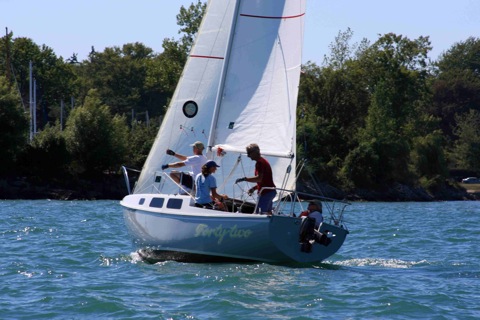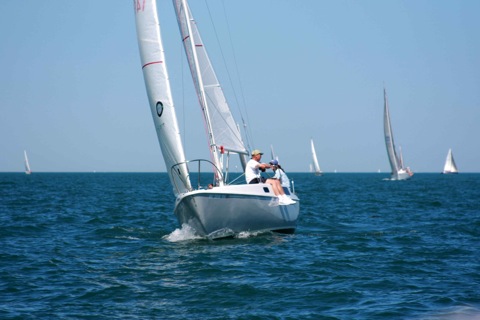Is your Cal 25 Properly Insured?
Cal 25 Owner learns that his ’25 was not.
A big thank you goes out to Detroit Cal 25 owner Dave Simon for educating us all!
To: Cal 25 Racers
Subject: Cal 25 Insurance – Agreed Value Policy
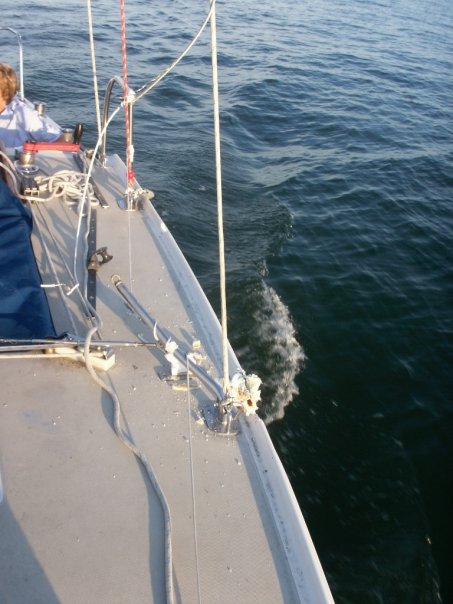

The after collision pictures.
The market value of used sailboats continues to drop, while the costs of repair, maintenance, sails, and rigging continue to rise over time. In the event of an insurance claim, that can put the insurance companies in a position to determine a very low “totaled” value versus the costs of getting your program going again.
On September 3, 2009 “Forty-two” was t-boned by a larger boat. Nobody was hurt, which is of course the most important thing. The other owner acknowledged full responsibility, and his insurance company at first indicated that a check would be quickly forthcoming to cover the structural, rigging, and sail damage. On November 4, 2010, after a 14-month battle, I deposited a settlement check. A lot of ugliness could have been prevented had I followed one very specific action:
Have “Agreed Value” insurance on your boat for an amount that would allow you to quickly put together another boat, rigging, and sails to go racing with the equipment level to which you are accustomed.
My insurance policy, through my ignorance and neglect, was an “Actual Value” policy. This means that my insurance company would only be obligated to pay me a depreciated or “market value” amount relative to the policy maximum. Furthermore, my policy maximum was set at what I had purchased the boat for in 2003, and did not account for the new sails, interior re-tabbing, new rigging, bottom work, etc….but that really didn’t matter because of the very low “market value” of 40-year-old 25-foot sailboats. I had inadequate insurance, and there was no way I could go racing again on the amount my policy was going to pay out; thus it was logical to make a claim against the other guy’s liability insurance as boating liability is “who’s fault”, not “no-fault”. It was all fine until they started finding “excellent condition” Cal 25s for sale around the country for less than we pay for a couple of new sails. Insurance adjusters don’t care that we hot rod them up and race them. The ugliness involved lawyers, litigation, and pulling repair funds out of places you aren’t supposed to touch. Yeah, we won, but it was not pleasant.
I owe a huge thank-you to the Detroit Cal 25 fleet for a tremendous amount of support during the winter of 2009-2010. As the collision hit directly on the mast beam, the fiberglass damage was fairly minor and we chose to dive in and make repairs (plus some extra work) versus waiting for the insurance mess to clear up. Brian Shenstone provided immeasurable advice and guidance, many hours of labor, and his basement workshop. John Harper, Don Healy, Paul Nuechterlein, and Rick Zanotti all pitched in with time and talent to supplement the paid repairs, and I remain forever grateful to all involved. By the time “Forty-two” hit the water in the spring of 2010 she was in fine shape, and we had a very fun 2010 season. We have a great fleet and this experience has served as a reminder for how much we should cherish it.
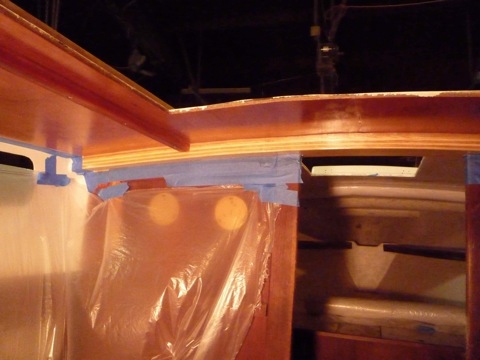
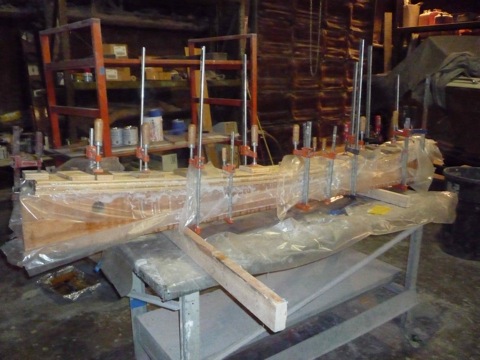
Repairing it over the winter.
All of the ugly stuff could have been avoided had I been more diligent about knowing exactly what was in my policy. In order to get an “Agreed Value” policy at an adequate value you will need to do the following:
- Contact your insurance agent and tell him you want to make sure you have an “Agreed Value” policy. You may or may not be able to find anything on the policy declaration page that tells you this, and as we are not experts the only way to know for sure is to have an explicit conversation with your agent.
- Decide how much you can really put your campaign back together for if your boat is totaled. Don’t assume you can make a friendly purchase from within your local fleet at the exact right time…you need to figure on buying a non-racing Cal 25 and then going to town on the bottom, replacing beams and bulkheads, adding equipment and sails, etc….it gets well north of $10,000 pretty quickly especially if you want a professional to do the work in a hurry. There is a big difference between eating fiberglass dust and snorting epoxy fumes for months versus hiring a professional yard to expediently get you back to where you were. It goes north of $16,000 if you think about a fire taking out your boat with your racing sails on board.
- Be willing to pay more money for your policy. My “Actual Value” policy of $6,500 was around $225 per year, and I now have a $20,000 “Agreed Value” policy at $425 per year. Deductible is $750 and liability is $300,000.
- Be prepared to pay for a survey, and to document the hours and dollars you have put into your boat since buying it. All that work putting barrier coat on the bottom, re-doing the bulkhead tabbing, and making new hatchboard covers should go into the boat’s value, as should your sail inventory, new halyards, etc.
- Shop around for coverage, or find an agent who will shop around for you.
Finally, if you won’t do it for yourself, please consider doing it for the other guys in the fleet. If you are underinsured as I was, and don’t have a pile of cash set aside to be effectively self-insured, it gets pretty darned inconvenient – and possibly expensive - for all involved in the event of collision damage.
Thanks,
Dave Simon
Cal 25 1498 “Forty-two”
Editors Note: After seeing a Cal 25 in sailing condition sold at auction for $10 at the Long Beach Marina impound auction I can’t stress enough the importance of an agreed value policy.
